This is an Exakta RTL 1000, a 35mm SLR camera made by VEB Pentacon Dresden between the years 1969 to 1973. Despite the Exakta name and sharing the original Exakta mount, this camera bears very little resemblance to earlier Exaktas, in fact, it was built alongside the Praktica L-series also made by VEB Pentacon. With interchangeable viewfinders, and support for the large number of Exakta lenses that already existed, it was hoped that the RTL 1000 might return the Exakta brand to clory, but by the time it was released, the Exakta name had fallen out of favor with professional photographers, and as a result, the model sold poorly.
Film Type: 135 (35mm)
Lens: 50mm f/2 Carl Zeiss Jena Pancolar coated 6-elements
Lens Mount: Exakta Bayonet
Focus: 0.5 meters to Infinity
Viewfinder: Interchangeable SLR Prism (not compatible with earlier Exakta viewfinders)
Shutter: Vertically Traveling Metal Focal Plane
Speeds: B, 8 – 1/1000 seconds
Exposure Meter: None in Camera, accessory TTL Viewfinder with Coupled CdS Cell w/ viewfinder match needle
Battery: None in Camera, 1.35v PX625 Mercury Cell in TTL Viewfinder
Flash Mount: None on Camera, requires external coldshoe bracket with PC X-sync port
Weight: 750 grams (body only), 936 grams (w/ Pancolar lens)
Manual: http://www.ihagee.org/Manuals/ECM41-RTL1000E71.pdf
Meter Manual: http://www.ihagee.org/USA/USA80-RTL1000meterinstruc.pdf
Accessory Catalog: http://www.ihagee.org/USA/USA47-RTL1000+TTL.pdf
History
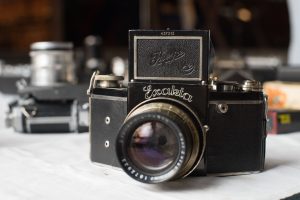
Ihagee and Exakta are hallowed names in German camera history. Ihagee was founded in 1912 by a 25-year old Dutchman named Johan Steenbergen as Industrie-und Handelsgesellschaft which stands for Industry and Trade Society. Often referred to by the nickname IHG, the company name was eventually shortened to Ihagee Kamerawerk since Ihagee is pronounced the same in German as saying “I H G”.
Many of Ihagee’s early models were folding cameras like those made by nearly every other German company at the time, but in 1933, Ihagee made its first significant splash in the camera industry releasing its first “miniature” camera which they called the Exakta. This first Exakta took 4cm x 6.5cm images on 127 roll film and was the world’s first compact Single Lens Reflex camera. In 1936, Ihagee would release a revised variant designed for the new 135 format 35mm film, which they called the Kine Exakta. The word “Kine” was short for the word “cine” or “cinema”, and never appeared on the camera itself, but was used in literature to differentiate the 35mm film version from the original 127 roll film “Vest Pocket” Exakta.
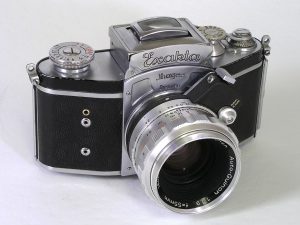
Designed by Ihagee’s resident engineer Karl Nüchterlein, the Kine Exakta contained several advancements that hadn’t been achieved by camera makers of the time such as a magnified ground glass for easier focusing, a lever for advancing film, a shutter activated flash socket, and a quick change bayonet lens mount. The Kine Exakta would remain in production until the start of World War II and would resume shortly afterwards.
The Exakta wouldn’t become a serious contender for professional photographers until 1950 when the Exakta Varex made it’s debut. The big deal with the Varex was that the waist level viewfinder was removable and in its place an optional pentaprism eye-level finder could be installed. You can easily tell a Varex from a non Varex model by the presence of the release lever on the front nameplate of the camera. This was significant as it meant that the Exakta could be used in both waist-level and eye-level configurations and in a number of alternative applications.
Over the course of the next decade, the Exakta would receive many incremental upgrades and changes. It wouldn’t be until the Exakta Varex IIb from 1963 – 1967 where more than a year or two would go by without any changes. During this time, a huge number of lenses, viewfinders, and other accessories were released for the Exakta. Adapters were created so Exaktas could be used in as far reaching fields as astronomy, endoscopy, and other scientific and medical fields. Although many people think of the Nikon F when the topic of a professional 35mm system comes up, it was the Ihagee Exakta that started it all.
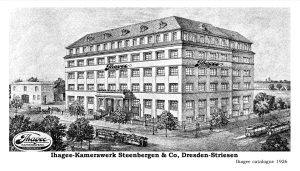
Ihagee was located near Dresden, which after the war would fall under Soviet rule and become a state owned entity heavily influenced by the government. Unlike many pre-war Dresden based companies, Ihagee was afforded a little more independence than some other camera companies and throughout most of the 1950s managed development and production of their own cameras separate from other companies like Zeiss, KW, and Certo who were managed by Pentacon. I’ve read differing accounts as to why this happened, some said that Ihagee’s Dutch owners allowed the East German government better trade relations with the Netherlands, and other’s have said that it was due to the Exakta itself being such a unique and popular camera that the government decided to leave well enough alone.
Whatever the case, Ihagee saw tremendous success throughout the entire decade of the 1950s and early 60s. The Japanese camera industry was exploding, releasing new models on a regular basis, but the Exakta system continued to do well…for a while.
By the early 1960s, demand for the Exakta started to slow, management and government officials from after the war began to retire and move onto other positions, bringing in new ideas and a greater sense of unification. Pentacon’s oversight expanded beyond financial planning and they started to influence the release of cheaper models like the Exa SLR. Quality control began to suffer as a result of cost cutting measures, and by the late 1960s, models like the Exakta VX500 were produced without slow speeds, and a top 1/500 shutter speed. Slowly, Ihagee Dresden began to lose it’s identity.
In late 1966, marketing materials simply mentioned Exakta by name only and the identity of Ihagee Kamerawerke AG was omitted. In 1967, officials demanded that the Dresden camera industry focus on Praktica models and that a new Exakta should be created with modern features like an instant return mirror and a revised viewfinder and viewfinder mount. By 1968, all traces of an independent Ihagee had all but vanished. Only the names and the physical factories remained, all management, design, and production was controlled by Pentacon and the East German government.
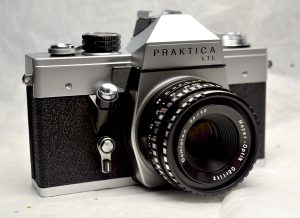
In 1969, a Pentacon designer named Herbert Scholtze was in charge of developing a new dual Praktica/Exakta camera with an all new body, and several modern upgrades. This new camera would eventually become the Praktica L-series and the Exakta RTL 1000. First shown at the 1969 Leipzig Autumn Fair and released to the market in December 1969, the new Exakta model had a long list of improvements:
- Modern squared off body with right handed controls
- Vertically traveling metal blade shutter with electric flash sync of 1/125
- TTL metering with a special viewfinder
- Automatic resetting exposure counter
- A revised lens mount supporting lenses with an internal automatic diaphragm (compared to the external trigger on previous Exaktas)
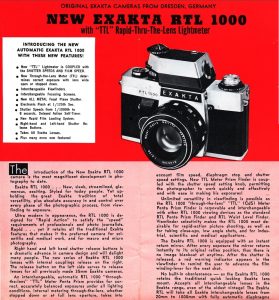
The RTL 1000 would retain backwards compatibility with all earlier Exakta mount lenses, and although it would still offer interchangeable viewfinders, they were not compatible with earlier cameras. Production of the camera was side by side with the Praktica L-series and was the first Exakta branded camera not made in an original Ihagee plant. The camera was in production until 1973 and a total of 86,050 units were built. Three variants exist with only cosmetic differences in the nameplate.
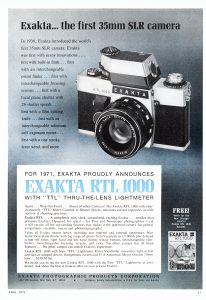
The movement of production of the RTL 1000 to the Praktica plant was the final nail in the coffin for Ihagee as the very next year, permanent arrangements were made to lease all buildings, machines, and other equipment to other companies. In early 1971, the Ihagee trademark was de-registered.
The names Exakta and Exa would live on until at least 1987, made entirely by Pentacon and were mere vestiges of a once great company. The Exakta mount itself would be discontinued in the 1980s on later Exa models, replaced by the M42 screw mount.
Today, the Exakta brand is a highly regarded name in camera collector circles…usually. The RTL 1000 has a distinction of not only being labeled a “fake-Exakta” but also doomed with poor quality control consistent with East German cameras of the early 1970s. Still, despite it’s bottom-tier reputation for collectors, the RTL 1000 is an interesting camera, marrying the Cold War utilitarian design of the Praktica with an interchangeable viewfinder, with a wide range of shutter speeds, and support for one of the most successful 35mm SLR lens mounts ever. These cameras don’t show up for sale often, but when they do, their reputation usually keeps prices low, making them worth at least a passing look.
My Thoughts
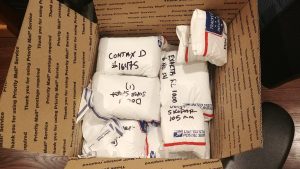
This Exakta RTL 1000 came to me as a bonus camera in a box of cameras donated by fellow collector, Johnny Sisson. I was vaguely aware that some Exakta models had been produced after Ihagee had officially been absorbed by Pentacon, but never really paid much attention.
Once I had my hands on one though, I was quite impressed with the imposing dimensions of the camera. On one hand, the large cubed rectangle shape of the body with sharp 90 degree angles was reminiscent of Praktica SLRs made from the same era, but where 1970s Prakticas are generally rudimentary screw mount SLRs with few features and a limited shutter, the Exakta RTL 1000 seemed, at least at first, to be quite a bit more.
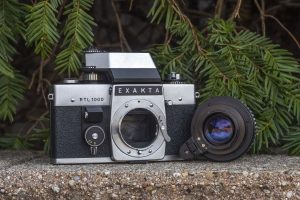
For one, the Exakta RTL 1000 retained the original Exakta bayonet mount, but slightly modified to support an internal aperture pin, much like the M42 screw mount cameras that Pentacon had a lot of experience with. This means that there were special Exakta mount lenses made for this camera that could automatically stop down the diaphragm without the use of an external button, like all other Exaktas did. This not only was more convenient for the user, but also allowed for the shutter release on the RTL 1000 to be relocated to the photographer’s right side of the camera.
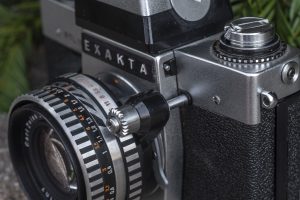
Pentacon was smart to not completely abandon what amounted to nearly 5 decades of Exakta mount lenses that came before the RTL 1000, as this model retains full functionality with those old lenses too. The photographer’s left side of the camera has a secondary shutter release that when used with a screw-in extension rod, would support the automatic diaphragm of earlier Exakta lenses.
The viewfinder is removable and a variety of metered prism, standard prism, and waist level viewfinders were available, although they are not compatible with original Exkata viewfinders. Had the RTL 1000 been a successful camera, this change would have likely been well received as the latching system for the RTL 1000 viewfinders was at the back of the camera and much easier to get on and off, compared to the original design.
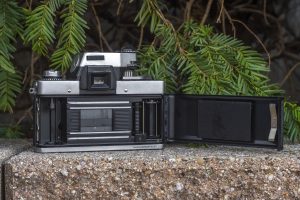
Another upgrade for this camera is that it has a vertically traveling metal blade shutter which improved electronic flash sync to 1/125 second, compared to 1/30 and 1/60 on the earlier cloth shutter models. As a general rule, metal blade shutters are considered to be superior and more reliable than horizontally traveling cloth shutter as they are tougher and not prone to pinhole light leaks or tearing. The problem however, was that unlike most metal blade shutters of the day made by precision companies like Copal, the RTL 1000’s shutter was developed in house and was prone to failure. RTL 1000s quickly developed a reputation as being problematic cameras that in some cases came out of the factory with issues. As a result, few of these Pentacon built Exaktas are found in good working condition today.
Which brings me back to this particular camera. When I received it, I knew it didn’t work. The shutter was perpetually in an open position and would momentarily close as you cocked the shutter, but would immediately fire upon completing the complete motion of the advance lever. Not willing to jump into most SLRs, let alone a German made one from an era where quality control was notoriously bad, I decided to douse the entire shutter in naphtha oil to see what would happen. My thought was that this being an all mechanical camera with little electronics, and possibly a sticky shutter, maybe the “magic juice” that is so often used to free up sluggish/stuck shutter might help….
Nope! The RTL 1000 remained in it’s inoperable state. I can’t be sure of this, but based on the poor reputation for quality control that these Pentacon Exaktas had, there is a good possibility this particular camera had been plagued with this issue since it was new. I wasn’t about to open the camera and attempt to repair it myself, and of course paying a professional to do it was way out of line so I decided this camera would stay broken.
Knowing that I’d never shoot a roll of film through the camera, I still thought it was worthy of some sort of review, so I decided to do one anyway. This is an SLR that uses the same exact lenses as any Exakta, so from an image quality standpoint, the images should look exactly the same as those shot with the same lens on an older Exakta body. If you’d like to see some sample photos shot on an Exakta, check out my review for the Ihagee Exakta VX.

As I mentioned earlier, the Exakta RTL 1000 has a very squared off rectangular body. Many of the design elements of the camera are similar to the Pentacon L-Series from 1970 and on, which suggests that the two are likely built off the same platform. The camera is large and heavy, weighing 750 grams body only but with the metered prism. When I mounted a Zeiss Pancolar 50mm lens to it, the weight grew to 936 grams. The Pancolar is one of the lighter Exakta lenses out there, so the larger the lens, the heavier the overall camera would be.
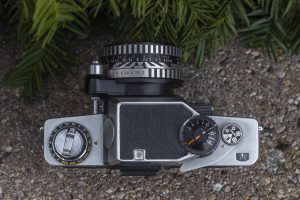
The top plate is setup much like you’d expect an SLR from the late 60s/early 70s to be. The rewind knob with film reminder dial on the left, prism in the middle (in this case the metered TTL prism), shutter speed dial (which is covered by the redundant dial on the meter), film advance lever, and exposure counter.
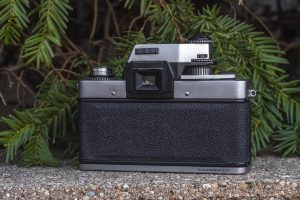
The most obvious sight on the back of the camera is the back of the large metered prism sitting on top of the camera. It’s a bit disappointing that Pentacon couldn’t design this with in body metering like the Topcon RE Super had 8 years sooner but not all that surprising as East German companies weren’t exactly known as cutting edge innovators either.
You might have noticed that the RTL 1000 features shutter speeds as slow as 8 seconds, but nothing slower than 1 second appears on the shutter speed dial on top of the camera. Like the original Exaktas that came before it, the RTL 1000 uses the self timer as a way to achieve shutter speeds longer than 1 second.
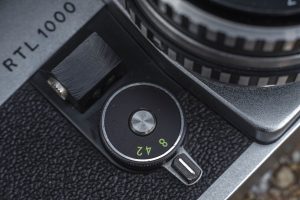
In the image to the right, you’ll notice the numbers 2, 4, and 8 on the self timer dial. In order to use these ultra long shutter speeds, you must first set the top shutter speed dial to “B” for bulb mode. In doing so, the self timer now becomes a long speed shutter selector. With the camera in “B” mode, rotate the self timer lever clockwise as far as it will go and then rotate the dial in the middle of the self timer so that one of the numbers 2, 4, or 8 is aligned with the white mark on the self timer lever. When you are ready to fire the shutter, use either of the main shutter releases. As with all long shutter speeds, it is critical that the camera is stabilized on a tripod or some other type of rigid surface.
Conclusion
I was never able to get this camera to work properly which means I couldn’t shoot any film in it. In the image above showing the film compartment open and the metal shutter, I could only get the shutter to close by partially winding the camera up until the point at which it would always release itself and stay open. Had I loaded film into this camera, the shutter would have perpetually remained in an open position, ruining the film.
Despite not shooting any film in the camera, I did play with it enough to get a feel for how it might have worked. 1970s Prakticas are relatively rudimentary cameras that worked like any number of other full frame mechanical SLRs of the day. Sure, there are some unique features like the 8 second long shutter speed selector on the self timer, and even by 1970, metal blade shutters like this one weren’t in widespread use, but this is hardly an innovative camera.
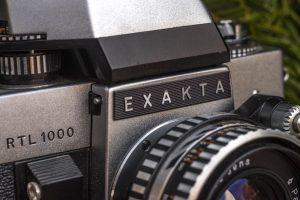
It is clear to me that Pentacon had intentions of improving the tired Exakta system and adding modern features that by it’s release had been common in many other SLR systems. From a specification standpoint, the RTL 1000 is not a bad camera. The large and boxy body was not out of line in late 1969 when it was released, a wide spread of shutter speeds with a 1/125 electronic flash sync, and interchangeable viewfinders would have likely made it desirable by pro photographers with a library of existing Exakta mount lenses. Even the marketing department did a pretty good job of championing the camera’s best features.
It’s greatest failure was in the quality control department. Sadly, this was the case with many East German cameras made in the 1960s and later. The socialist government in East Germany did not put as high of an emphasis on innovation and high quality standards as the Japanese did. Their focus was on making products for the masses. The Praktica line remained popular through the 1990s for this very reason.
I will fully admit that I had no interest in this camera before acquiring one, and even after seeing it in the box, it was the last that I freed from it’s plastic bubble wrap cocoon it was shipped to me in. After playing with it, it grew on me. Not enough to attempt a repair on, or even seek out a better example on eBay, but enough to take the time to write this review. I would say that based on my experience, if you were to find one in good working order, and you have some Exakta lenses to use with it, don’t dismiss it. Give the RTL 1000 a chance and let me know your thoughts. Just don’t rave about it too much, as I’m trying to buy LESS cameras, not more!
Related Posts You Might Enjoy
External Links
http://camera-wiki.org/wiki/Exakta_RTL_1000
https://oldcamera.blog/2017/07/19/exakta-rtl1000/
http://www.earlyphotography.co.uk/site/entry_C753.html
http://blia-gear.blogspot.com/2013/07/exakta-rtl1000-last-exakta.html?_sm_au_=iVVJ4FPHnK7MDMW6
http://www.collection-appareils.fr/x/html/camera-2893-Ihagee_Exakta%20RTL%201000.html

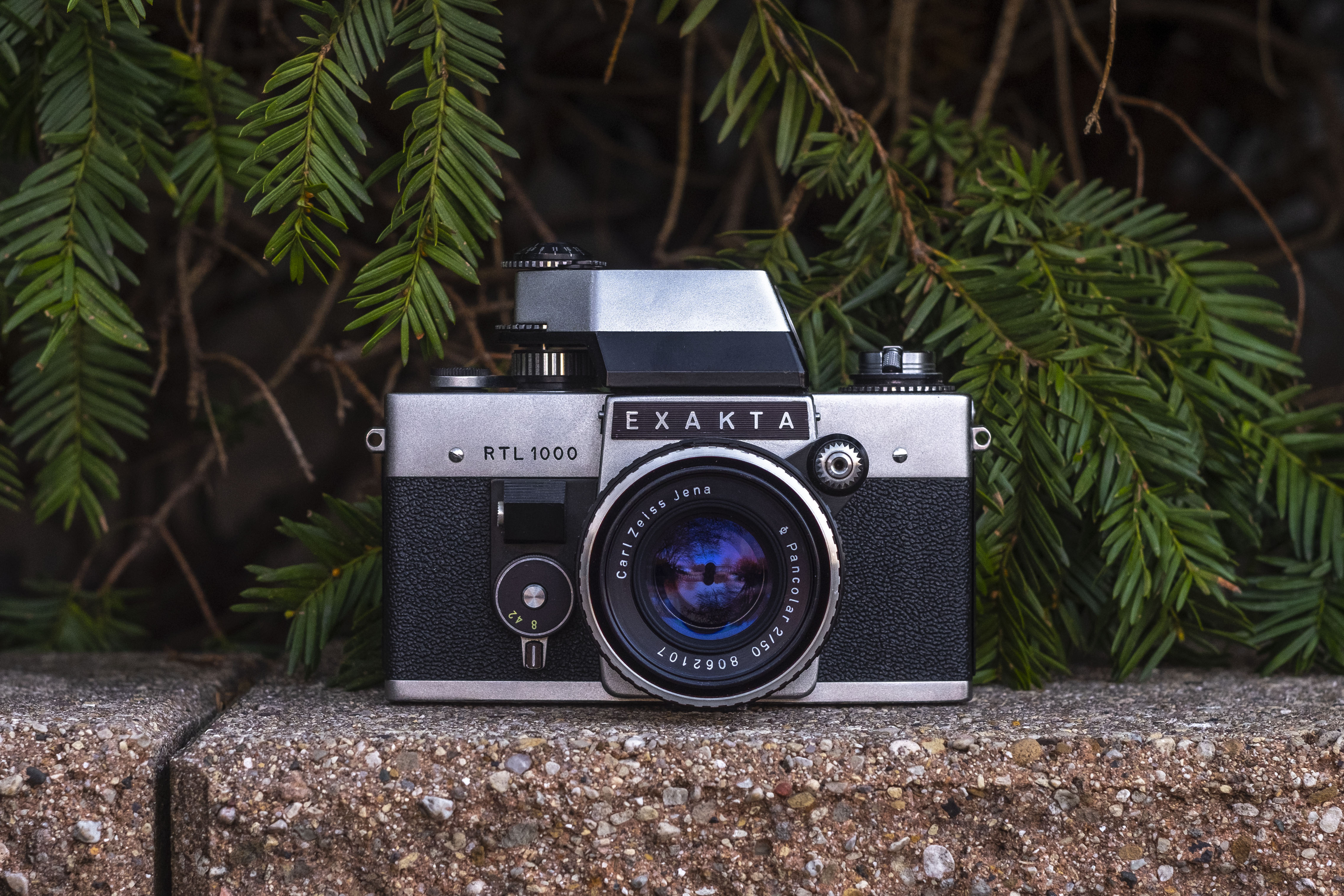
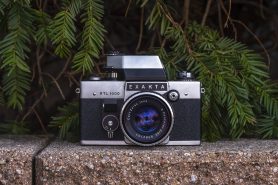
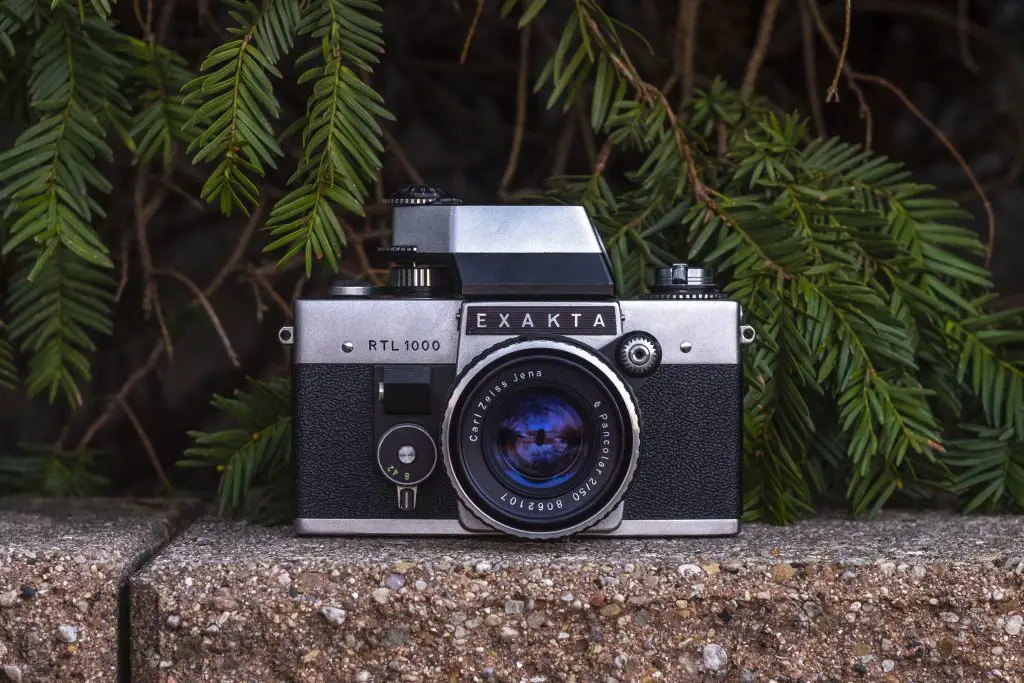
Seeing an Exakta name plate on this boxy camera from the 1970’s is akin to seeing the classic VW logo on the likes the Rabbit, ok maybe not since they’re not using the classic script logo, but you get the point…
The in-body release for the special lenses while accommodating older lenses, and the addition of a metal blade shutter SOUNDS like it would make for a much more robust camera than the classic models like the Varex, even without the removable VF’s, but your experience certainly doesn’t bear this out. Still, I get the feeling that a working example of one of these will fall in your lap sooner rather than later.
I love this camera, I guess I am the odd man out. My two work fine, meters excepted. Great fun to shoot with. As you say, not much in common with earlier models except the lens mount.
I liked it too. As I said in the article, I had no interest in this model until one was given to me in a box with other stuff I wanted more. It wasn’t until after holding this thing that it started to grow on me!
I just got one of these in the post last week and am currently putting a roll of 24 through it to test. I think I might have got lucky in that it sounds mechanically good and was near mint inside.. Only issue was the WLVF being a bit dusty but nothing a blow out didn’t make a bit better. I’ve only really started shooting film properly (had a few dabbles a while ago) so I’m working my way through my small Praktica and rangefinder collection this now to both test them and get used to film. ive got to admit though, the RTL 1000 does take a bit of getting used to being totally manual and composing via the WLVF, which does make you look a little odd when trying to compose a shot.. 😀 The only negative I’ve found so far is more to do with the Meyer Goerlitz Oreston 1.8/50 that came with it seems pretty difficult to focus at minimum focus distance; though that should be pretty darn close at a third of a metre. Will have to experiment more, possibly using a tripod, to see how close it can get though..
The best advice I can give you in regards to composing with a WLF is to use it to it’s strengths. Get low and shoot images of children, pets, or other “low” things near the ground. I have a fondness for shooting statues of angels and cherubs in cemeteries and other places, and a favorite shot I like to take with cameras with WLFs are to put the camera near the base of the tombstone/statue and get a picture looking up at it. While you can certainly shoot that camera at eye level like any other camera, I find that it’s just not as fun.
I had one of these new back in the 70’s. It worked for me and gave good results, had the TTL model. It was moved on and traded up along the way and I now regret that. So I acquired one, however, as stated before, they are a bit like the Curates egg, and this one has a problem
it fires the shutter immediately on winding on, does not release the mirror and does not retract the aperture setting pin when wound on. It appears that the winding mechanism is not triggering the reset of these items after the exposure is complete. Shutter timing is fine. If I physically reset the aperture bar and unlock the mirror the camera winds on and fires correctly but then remains stuck in the mode I described.
Appreciate any information as to what may be causing this and if possible a copy of the service manual for the camera.
Yours is behaving exactly as mine did. Shutter always fires after winding on and the mirror gets stuck. I doused mine with naphtha and took off the bottom plate to see if there was anything dislodged or obviously wrong in there, and nothing helped. Since that is the extent of my SLR repair abilities, I left it alone and in the time since I originally wrote this review, never got it to work. Sad to say, but it sounds like yours is equally dead.
Terrific, thorough review! I’ve enjoyed your other reviews of cameras in my collection and there’s a nice bit of serendipity about how I arrived at my two favorite cameras (and a very close 3rd) through the Exakta RTL. As a US Army bandsman stationed in Berlin in the very early 70s, I became interested in cameras, which we were able to buy at discounted prices through the PX. But none were as deeply discounted as the Exaktas that we could buy in East Berlin because of a very favorable currency exchange rate. Since I was in Berlin, I was also intrigued with these cameras, much more so that the Petris and Pentaxes some of my friends had. The VX1000s seemed old-fashioned to me and I wanted something more up to date, so I chose the RTL1000. It served me very well for another 20+ years and I accumulated a few nice lenses along the way. I also ultimately bought a VXiib, just to have. Unfortunately, a friend dropped and broke my camera, and at that time (before Ebay) it was hard to get a replacement and was going to be expensive to fix. So I decided I’d get a more modern camera and purchased an Olympus OM10 at a good price. I also picked up a couple of Zuiko lenses along the way. The OM10 proved to be a dog. It soon stopped working, I had it repaired, and it failed again. I got an OM2000 to replace it, but never was satisfied with it. It was hard (maybe almost impossible) to focus properly, so I began contemplating my next move. I’m not a wealthy person by any means (a musician – get it?) so cost was important. I began reading about the Topcon RE Super that used the Exakta bayonet-mount, and I wanted a camera with a light meter. I decided to get one, and I found one at a really good price on Ebay. What a revelation! This camera was built like a tank, yet it never felt bulky in my hands, as the ergonomics were excellent. It had removable focusing screens and removable pentaprisms, really everything the Exakta had, but more – especially the build quality. I’ve loved this camera ever since, and my appreciation for it only grew when I acquired their 58mm f1.4 lens. It’s amazing.
But what was I to do with my excellent Olympus Zuiko lenses? I had been dreaming of an OM4 for a long time and decided to take the plunge. This camera is equally amazing in its own ways. It’s not as easy to focus as the Topcon, but in every other way it’s equally amazing. I love it and use the two systems equally.
What about my third favorite? Knowing about my interest in cameras, my dad asked for my help in selecting a really good film camera. At that point in time, I thought the Minolta SRT101 would be his best choice. It’s very basic, works perfectly, and is quite rugged. I got him one for Christmas and he loved it. As things go in this life, my dad passed in 2007, so I became the new owner of his camera. Along the way, I’ve accumulated a few more Rokkor lenses, and have enjoyed this camera a lot. It doesn’t “speak” to me mechanically, quite like the other two do. Even though it’s just about as heavy, it doesn’t have quite the luxurious feel that the Topcon does, and because of its heft, it doesn’t have the agile feel of the OM4. Still, it’s a great camera and I’m grateful to have it. The Rokkor lenses have a warmth to them that sets them in a category by themselves. Clearly, I love film cameras, and I’m grateful to this website (thanks, Mike) for all the great information! Thanks for indulging my ramble.
I previously wrote a long, rather rambling account of how the Exakta RTL1000 brought me to the Topcon RE Super and even the Olympus OM4. It was more about that than this camera, which was a mistake in judgment on my part – definitely more interesting to me than anyone else. I will try to make amends with a few words about my direct experience with this camera.
I bought an Exakta RTL 1000 in 1971 in East Berlin while stationed in the 298th Army Band in West Berlin. I greatly enjoyed using this camera for over 20 years until a friend dropped it and the shutter would no longer function in 1998. I’ve since replaced it and still use the replacement. I’m surprised to read about the shutter malfunctions on here, as my replacement camera works very well, just like the first one I had until it was dropped. Unfortunately, I’ve never found a metering prism (the TTL prism) for this camera in working order (as mentioned below).
One of the things very few people mention is the plethora of accessories that were available for this camera. I’m sure the developers had very high hopes that it would once again place the Exakta name at or near the top of 35mm cameras, just as the VXs once had been. I have a beautiful bellows and close-up rings, as well as several different focusing screens for this camera. I think the largest problem with the camera was the kludgy metering (TTL) pentaprism that was pretty primitive compared to the Nikon F, let along the elegant Topcon RE Super that preceded it by 6 years. I have never since seen one of these metering pentaprisms that is still functioning, unlike my RE Super. Still, everything else works very well and the long list of lenses by such firms as Carl Zeiss, Angenieux, Schneider Kreuznach and other many others is a huge plus for owners over this camera. I absolutely don’t regret buying this camera and have happily shot countless rolls of film over the decades with this camera.
On the subject of the TTL meter, following on from my somewhat challenged RTL 1000, I managed to source an East German repair manual for the RTL 1000 so hope, shortly, to embark on a journey of learning which may end up with a working example. However the manual does not cover the TTL prism.
I am a fair hand with electronics, and the age of these cameras implies that the metering circuit is probably made up of discrete components – so if I can get it apart I will probably be able to repair it. Unfortunately getting it apart is proving difficult! I have removed the leathercloth and the three retaining screws, the top cover is definitely loose, it moves about 5-7mm, however the shutter speed dials are preventing removal and I cannot see how they come apart.
Does anyone know of a repair manual for this unit or know how to take it apart?
in the interim, I bought another camera, operational but with…. a faulty TTL prism!
I suspect the prism failures are due to the battery having been left inn and despite cleaning out the corrosion, from the cell chamber, it has spread up the inside of the wire and disconnected the power from the metering circuit – a reasonably common type of failure with battery powered meters.
Any assistance appreciated.
I don’t have anything helpful to add as I’ve never seen a repair manual for the RTL 1000, but wanted to say thanks for sharing what you know and I wish you good luck! 🙂
Mike, I regret that I’ve overlooked one obvious point: This is NOT an Ihagee Exakta RTL1000. In fact, there is no such thing. This camera was never made in the Ihagee factory – it was entirerly built by Pentagon in a separate factory. Quoted from the book “Ihagee – the Men and the Cameras” by Peter Longden: “The new Exakta RTL 1000 (120) was shown at the Leipzig Autumn Fair in 1969. So were the Praktica LLC and the Praktica L. All showed many similar details. Production of the Exakta RTL 1000 was not in the former Ihagee factory, but integrated into the production line of the Praktica L-series.” This is also born out in another book, “Exakta Cameras 1933-1978” by Clément Aguila and Michel Rouah. I have a couple of RTL1000s and there is no Ihagee branding anywhere to be found. I also own an Exakta VX iib and the Ihagee name is engraved on the body and on both of the finders I own.
A fascinating movie about all of this is “Exakta – the Rise and Fall of a Legendary Camera” by Gunter Eiselt.
Also, interestingly in the picture you show of this camera is the older Zeiss 50mm f2 Pancolar lens, which was never offered with this camera by Pentacon. Perhaps it was sold this way by a dealer in the west who had leftover lens stock or someone bought an RTL body and used this older lens with it. The two standard lenses for the RTL were the Meyer Orestor 50mm f1.8, and later the newer Zeiss Pancolar 50mm1.8, a wonderful lens.
In closing, you should consider moving this camera over to your Pentacon chapter and remove the name Ihagee from the title. It would be good however, to retain some mention of it over here, as the Exakta name was associated with Ihagee for decades. The Exakta story is fascinating for many reasons, not the least of which are the lessons learned when government hacks get involved with the day-to-day decision making of a technology enterprise.
Again, love this website!
Thanks for the correction Doug! I have updated the title, intro, and a few other areas of the article to get the information correct. I wrote that review quite a while ago and clearly skimped on research. The fact that I was never able to shoot it, likely caused me to skim though it. One day, I would like to find a working example, but its been nearly 4 years since that review and one hasn’t come my way yet. I ended up selling that model in a purge of nonworking cameras, so I don’t even have it anymore.
Excellent revision! Also enjoyed your article on the “Nacht Exakta!” First-rate!
Here is a short advice, how to repair RTL100.
https://learncamerarepair.com/downloads/pdf/Exakta-RTL1000E-cam-craftsman.pdf
Hope it can help.
Regards
Marek
Thanks for the review!
But I cannot agree with it.
Very often Praktica reviews mention a poor quality control. At the same time, no one wrote what exactly this control consists of. Because overall build quality of Praktica cameras is not far from the japanese cameras. The real reason for certain problems with Praktica is the failure of several camera components. Shutter winding unit or mirror mechanism. This is a design issue because of a plastic gear and some aluminium parts inside the camera. Praktica shutter is quite reliable and breaks very rarely. I think it doesn’t work due to the shutter and mirror being out of sync in your camera. It is a common issue.
Exakta RTL1000 is built on the same platform as Praktica L. They are almost the same cameras and they share the same problems.
Thanks for the comment. In regards to poor quality control, I can’t speak for other reviewers, but based on my own experiences, the later Pentacon cameras like the Praktica L-series and Exatka RTL1000 don’t hold up as well as other cameras of the same era. Even earlier Prakticas, like the Praktiflex and Prakticas IV and V (which I have also reviewed), are pretty well built and have a chance at still working. That’s not to say that a properly serviced RTL 1000 can’t still be a good camera, but again, in my experience, they just don’t hold up to time very well.